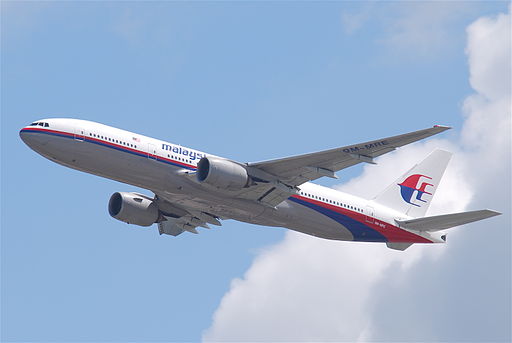World news
Flight 370: Airport 2014

Flight 370 vanished from the sky six days ago. Lead after lead to possible wreckage has proved false. Authorities now are losing patience with reporters, almost telling them to shut up. This story now begins to look like a thirty-seven-year-old Hollywood movie. But the scenario could be far more dangerous – to other people.
The latest on Flight 370

Map of the South China Sea, showing how far Flight 370 could have flown while it was sending telemetry after its transponder fell silent. Source: The Wall Street Journal. Click to go to the original image.
Contributor Dwight Kehoe listed several relevant facts we knew about Flight 370 two days ago. They included relatives and friends of passengers of Flight 370 still being able to get ring tones when they called those passengers’ smartphones.
This morning The Wall Street Journal published an electrifying new report. A modern airliner, including the Boeing 777-200ER (“extended range”), sends telemetry to the builders of the plane and the engines in real time. The theory is simple: if one of those planes crashes, the plane maker and engine maker want to know why, to try to stop or at least put off the next crash.
Flight 370 was sending telemetry to Boeing and to Rolls Royce, the engine maker, as late as 1:30 a.m. local time. But Flight 370’s transponder had stopped sending four hours and thirty-five minutes earlier.
At last report, Flight 370 was cruising at 480 knots airspeed. In four hours and thirty-five minutes it could have flown twenty-two hundred nautical miles after the transponder fell silent. Flight 370 could have made it to Beijing as scheduled. Or it could have crossed over most of India, or part of Western Australia, or Bangladesh, Myanmar, Vietnam, Laos, Thailand, or any number of islands in the South China Sea and the Indian Ocean.
Authorities in Malaysia deny this report. They also quote Rolls Royce as denying it. But Rolls Royce won’t talk. Furthermore, those same authorities tried earlier to say the flight turned left and headed west for several hundred miles. Then they took that back. Authorities seized on an earlier report that the Chinese had photographed pieces of flotsam nearer the original flight path. Ships and planes, searching for wreckage at that spot, found none.
Mr. Kehoe said it first. Someone hijacked that airliner and flew it to a “prepared” location. This morning the Journal quoted “U.S. counterterrorism officials” as saying the exact same thing.
What could hijackers do with it?
The Boeing 777-200ER can fly 7,725 nautical miles without refueling. This is not the Holy Grail of airliner range: the Great Semicircle Course. That course is more than 12,000 nautical miles long. A plane with that range could fly anywhere in the world from anywhere in the world, in one stop. But even the 777-200ER could fly from anywhere in that 2200-mile circle to an airport, or air base, within “strike range” of any of a large number of major world capital cities. Nor do they have to be civil government capitals. Financial capitals, like New York or Chicago, would do just as nicely for someone with nefarious intent. (Wikipedia has this page with “neutral” information on the Boeing 777 family of airliners.)
Thirty-seven years ago, Universal Pictures released a film, Airport ’77, also about an aircraft disappearing over water. A gang of art thieves, with the copilot in the lead, hijacks a 747 carrying a vast art collection. The copilot flies the craft under the radar and falsifies the transponder to mislead authorities. But he clips an oil rig with his wingtip and “ditches” in the Atlantic Ocean near Bermuda. For the rest of the film, the U.S. Navy tries to find the plane and get at least some of the innocent passengers out alive.
That is fiction. But mightn’t someone have sought to imitate that plot in life? The parallels are striking. A transponder falls silent, but telemetry keeps sending for more than four and a half hours. Passenger friends and relatives report a clear sign that some passengers, or at least some of their electronic equipment, still worked long after they shouldn’t have.
Those passengers are probably dead by now. If someone stole that airliner, that same someone probably murdered the passengers. (Unless he wants ransom for them, but if so, why hasn’t he demanded it yet?) He has what he likely wants: a guided missile having a range of 7,725 nautical miles.
But if this is “grand theft aero,” then it’s the most sophisticated theft anyone has ever done. A commercial airliner, precisely because it telemeters information about itself to its makers, is extremely hard to steal. This raises more questions about who might be able to steal an airliner this way, and why anyone that smart, or having that much coöperation, would do it.
[subscribe2]
Terry A. Hurlbut has been a student of politics, philosophy, and science for more than 35 years. He is a graduate of Yale College and has served as a physician-level laboratory administrator in a 250-bed community hospital. He also is a serious student of the Bible, is conversant in its two primary original languages, and has followed the creation-science movement closely since 1993.
-

 Civilization4 days ago
Civilization4 days agoDC Pipe Bomb Arrest Raises Questions About Christopher’s Wray’s FBI
-

 Civilization5 days ago
Civilization5 days agoThe Legal Logic Behind U.S. Operations Against Narco-Terrorist Networks
-

 Executive5 days ago
Executive5 days agoNewsom’s ‘National Model’ for Homeless Wracked by Fraud
-

 Executive2 days ago
Executive2 days agoWaste of the Day: Obamacare Failed Test, Approved Fraudulent Subsidies
-

 Executive4 days ago
Executive4 days agoWhen You’re in a Hole, Stop Digging
-

 Education3 days ago
Education3 days agoWaste of the Day: Taxpayers Subsidize Football Coach Severance
-

 Civilization3 days ago
Civilization3 days agoPence Calls on Trump To Fire RFK Jr Over Abortion Drug
-

 Civilization3 days ago
Civilization3 days agoRight-Wing Antisemitism, Liberalism, and Leo Strauss











[…] Flight 370: Airport 2014 […]
[…] (Editor’s Note: See also the reprint of Mr. Kehoe’s article here, and my editorial here.) […]